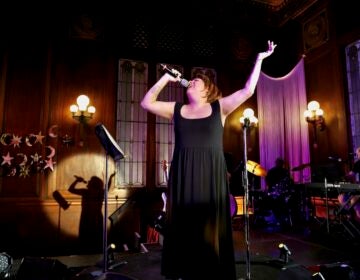Philadelphia crowd turns tables on N.Y. Times art critic
In a rare move for a newspaper critic, Ken Johnson faced friends and foes at the Pennsylvania Academy of the Fine Arts on Sunday, at a panel discussion organized in response to an angry petition signed by more than 1,600 people.
The art world firestorm was a reaction to two pieces Johnson had written for the New York Times, about an exhibition of art by women (“The Female Gaze” at PAFA) and an exhibition of African-American work (“Now Dig This!” at the Brooklyn Museum) in which he wonders if the show can have widespread appeal. “Those who identify may tend to respond favorably to what those viewing from a more distanced perspective may regard as social realist cliches, like a defiant fist,” he wrote.
The petition writers — a handful of mostly Brooklyn-based artists — complained that “Mr. Johnson organizes his [“Now Dig This!”] review around an oversmiplified opposition between the apolitical, ‘deracinated’ work of white artists and the political, ‘parochial’ work of black artists.”
Johnson said that is a misreading of what he wrote.
“There are questions about the value of identity politics as a primary motive for making art and evaluating art,” said Johnson a few minutes before he joined the panel in PAFA’s Samuel Hamilton building. “Identity politics still has a lot of traction in the non-profit world, among curators and museums, but far less in the commercial art market.”
Moderator Gwendolyn Shaw led panelists Kimberly Brooks of the Huffington Post, artists Joyce Kozloff and Njideka Akunyili, and Johnson, through a discussion about the role of the art critic in a multicultural landscape. Johnson registered his resistance to reading works of art through the artist’s racial or gender experience.
“That was an exciting thing to think in the 70’s,” said Johnson. “But when it’s institutionalized in academia and everybody has their own little identity turf, competing for funding with other identity stakeholders, and that leaks in the art world, I’m not happy about it.”
“And that comes out in your writing?” asked Shaw.
“Yeah, I might be a little cranky about that.”
When asked if her race and gender should be considered in an evaluation of her art, panelist Njideka Akunuyili, a Nigerian woman now living in the United States, said “if you don’t take into consideration my background and what I’m sourcing from, a lot of the work is missed.”
The trigger for the panel may have been some inflammatory statements about race and gender, but the subtext was old media vs. new media. Johnson, one of a handful of critics at the New York Times whose thinking wields considerable influence, was sitting next to Brooks, a Huffington Post editor who taps a pool of hundreds of bloggers representing a multitude of perspectives.
“Critics — even the name has teeth in it,” said Brooks. “It connotes more than putting forth a line of thinking. I had to recruit critics, hundreds of them, and not everyone who puts forth a line of thinking thinks of themselves as a critic. They don’t call themselves critics.”
Shaw turned to Johnson and asked if he, as an influential critic for the New York Times, feels the weight of responsibility.
“Art is about feeling. It’s not science,” said Johnson. “If you write about art as though there’s no feeling involved, then it’s as if you write about artifacts. And you can do that, but art isn’t art unless you’re engaged at some level of feeling. I’d rather be intemperate than responsible all the time.”
Johnson, clearly the centerpiece of the panel, was by turns jeered and applauded by the crowd of almost 300 people. “I think the people who don’t understand me have a literacy problem,” he said.
As moderator, Shaw, took some opportunities to needle him: when Johnson offered a breakdown of how the “male gaze” and the “female gaze” differ, Shaw asked if he normally references 40-year old art theory. Brooks then pointed out that the title of the exhibition at PAFA is “The Female Gaze.”
Shaw steered the two-hour discussion on a civil course, prodding the panel to think generally about representations of gender and race in the art world. One of the members of the audience, curator Sid Sachs of the University of the Arts Rosenwald-Wolf gallery, stood up and asked Johnson, “after decades of writing, why has the shit hit the fan now?”
“That’s what I want to know,” added Kozloff from the panel.
Johnson paused to consider.
“Well, because the discourse on artists is pusillanimous.”
WHYY is your source for fact-based, in-depth journalism and information. As a nonprofit organization, we rely on financial support from readers like you. Please give today.




